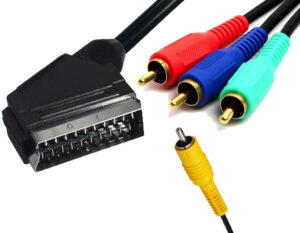The Evolution of Cable Television
Introduction
The 1980s marked a significant era in the history of television, as cable television gained popularity and transformed how people consumed content. While the modern-day convenience of streaming services and advanced remote controls seems ordinary, it is essential to recognize the challenges and innovations that shaped the rise and fall of cable television in the 1980s. This article delves into a comprehensive discussion of the cable TV era, exploring forgotten aspects and their impact on viewers and the industry. With insights from the original transcript and employee testimonials, we will unravel the fascinating journey of cable television and its enduring legacy.

Discussion
- The Birth of Cable Television
The roots of cable television can be traced back to 1948 when Ed Parsons of Astoria, Oregon, and John Walton of Pennsylvania independently sought solutions for better TV reception in areas with geographical challenges. These visionaries introduced cable systems that directly brought programs from nearby metropolitan areas into homes, providing a crystal-clear picture and access to a broader range of channels. The introduction of cable television was met with immense enthusiasm, and people eagerly embraced this new technology that expanded their viewing options beyond traditional broadcast channels. - The Cable Boom of the 1950s
In just ten years, from 1948 to 1958, the number of television sets in American homes grew from less than a million to over 42 million. Cable television played a crucial role in this boom by offering enhanced reception and a more incredible selection of channels. Cable companies like Wispark Cable in Pennsylvania and WEE Sports Cable in Pennsylvania pioneered cable services, bringing multiple channels from different cities and fostering healthy competition among cable systems. The 1950s laid the foundation for cable television’s rapid expansion and growing influence. - The Advent of Premium Cable Networks< In the early 1970s, premium cable networks emerged, introducing pay-TV services to subscribers. Bill Daniels and Bob Magnus were instrumental in establishing corporations like ATC (American Television and Communications Corporation), which later became Time Warner Cable. In 1972, ATC launched the first-ever pay-TV network, Home Box Office (HBO). These circumstances marked a significant milestone in the cable industry, offering subscribers exclusive access to various premium content. The success of HBO paved the way for the subsequent launch of other networks like Showtime, ESPN, MTV, and Nickelodeon, revolutionizing the television landscape.
- Technological Innovations and Challenges
As cable television expanded, technological advancements were crucial in improving the viewing experience. The transition from tube to transistor amplifiers reduced power consumption, improved signal quality, and simplified installation processes. However, challenges persisted, such as using coaxial aluminum sheath cables with styrofoam dielectrics, which were susceptible to water damage and required frequent maintenance. Nevertheless, cable companies and engineers constantly worked to enhance the technology and optimize the cable systems for improved performance and reliability. - Regulation and Decentralization
Regulation of the cable industry has been a constant factor since the late 1940s, with the Federal Communications Commission (FCC) and Congress imposing various regulations to ensure fair practices and consumer protection. In 1984, ATC embarked on a decentralization process, leading to the creation of the national division. This division focused on managing systems that didn’t fit into major metropolitan areas, providing opportunities for growth and innovation. The national division became a leader in promoting diversity and inclusivity within the industry, offering opportunities to women and minorities. - Cable Television’s Impact on Society
Cable television not only transformed the way people consumed content but also had a profound impact on society. The availability of many channels and diverse programming catered to viewers’ interests, creating a sense of community and shared experiences. Cable systems became a hub for local news, weather updates, and even specialized channels like The Weather Channel, offering hyperlocal forecasts. Moreover, cable television was crucial in broadcasting significant events, such as the legendary “Thrilla in Manila” boxing match, which became a shared experience for cable subscribers. - The Legacy of Cable Television
While cable television faced challenges, such as the rise of satellite services and increasing competition, its legacy is undeniable. Cable paved the way for technological innovations like digital services, high-speed data, and internet connectivity. The industry’s pioneering spirit and ability to adapt to changing consumer demands laid the foundation for the modern era of streaming services and on-demand content. Cable television also shaped the careers of many individuals, providing employment opportunities and fostering a vibrant and dynamic industry.
Conclusions
The cable television industry of the 1980s was a remarkable period of growth and innovation that forever changed the television landscape. From humble beginnings as a solution for improved reception, cable television evolved into a powerful force that challenged the dominance of traditional broadcast channels. With the advent of premium cable networks like HBO, the industry witnessed a paradigm shift, providing subscribers with specialized programming and exclusive content.
Technological advancements played a pivotal role in the cable television industry’s growth. The transition from tube amplifiers to transistor amplifiers significantly improved signal quality.
And energy efficiency, paving the way for a more reliable and cost-effective cable TV experience. Engineers and cable companies continuously worked to optimize the technology, addressing challenges such as water damage to coaxial cables and improving installation processes.
The regulation also played a vital role in shaping the cable television industry. The Federal Communications Commission (FCC) and Congress implemented regulations to ensure fair practices and protect consumers. The decentralization process initiated by ATC in 1984 created opportunities for growth and innovation while promoting diversity and inclusivity within the industry.
Cable television had a profound impact on society during the 1980s. The availability of a wide range of channels and diverse programming options fostered a sense of community among viewers. Cable systems became a reliable source of local news, weather updates, and specialized channels catering to specific interests. Viewers could tune in to channels like The Weather Channel for hyperlocal forecasts or experience significant events like the “Thrilla in Manila” boxing match together.
Legacy
The legacy of cable television extends beyond the 1980s. Cable paved the way for technological advancements that we still benefit from today. The industry’s innovative spirit and ability to adapt to changing consumer demands set the stage for the modern era of streaming services and on-demand content. The infrastructure and expertise developed during the cable TV era were a foundation for the digital revolution, enabling high-speed data transmission and internet connectivity.

Furthermore, cable television created numerous employment opportunities and shaped the careers of many individuals. From technicians and engineers to content creators and on-air personalities, the cable TV industry provided a dynamic and vibrant work environment that propelled the entertainment industry forward.
While cable television has faced challenges recently, such as the rise of satellite services and streaming platforms, its legacy endures. The foundations laid in the 1980s continue to influence how we consume media and shape the future of entertainment.
The cable television era of the 1980s was a transformative period that revolutionized the television industry. From its humble beginnings as a solution for better reception to establishing premium cable networks and its impact on society, cable television left an indelible mark. Its technological advancements, regulatory framework, and cultural impact paved the way for the digital age of streaming services and shaped the careers of countless individuals. The legacy of cable television is a testament to the resilience, innovation, and ingenuity that continues to drive the ever-evolving entertainment landscape.
How about the latest episode of ALF?
The 1980s – It never ends
You gotta try this amazing link that teleports you to another random article. Try it!
